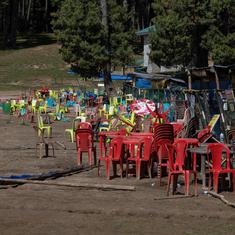At the age of 29, Sanya Malhotra plays a young widow in Pagglait. Sandhya is a quiet, simmering character dealing with the untimely death of her young husband. It’s a role closer to Malhotra’s Miloni in Photograph than the sparring Chhutki of Pataakha.
Written and directed by Umesh Bist, Pagglait will be premiered on Netflix from March 26. The cast includes Ashutosh Rana, Sheeba Chaddha, Raghubir Yadav and Sayani Gupta. Malhotra, who was last seen in Shakuntala Devi and Ludo, talks about her process for inhabiting a character.
What was your reaction when you heard that you were to play a widow in ‘Pagglait’?
I fell in love with the script and Sandhya. I was inspired by Sandhya’s journey and how emotionally mature she is. Like me, Umesh sir is also from Patparganj in Delhi, and I trust Patparganjis.
Initially, I did have a few doubts about being to pull it off, but our producer Guneet Monga and Umesh sir had so much confidence in me that I put my doubts aside.
Considering you had no personal reference to play Sandhya, what was the preparation process like?
As Sanya, I could not connect with Sandhya’s experience in any way. I had to crack her psychology, fill in the blanks on what happened in those five months of her marriage. Why is she feeling the way she is? When all around her are experiencing and expressing grief, why is she feeling weird?
I needed to comprehend what was going on inside her. I also wanted to have a good memory bank for Sandhya, so when I am imaging something in the scene, I have those images in my mind. Sandhya is a post-graduate in English Literature with a lot of time on her hands, so whenever I would think like her, I would write poems. I imagined that she would be someone who would journal her life.
How would you describe ‘Pagglait’?
It’s in a very real space. I have seen these characters in my own family. In fact, when I watched the film with my mother some months ago, she told me that something like this had happened to a close relative of ours.
After watching the film, my mother called this relative and asked her what she did with those photos she found. She said she had just recently burnt them. It took her 30 years to let go of that anger and frustration.
Pagglait speaks of the importance of letting go in order to start the next chapter. The film starts with death, but it ends with rebirth.
Do you get connected to your characters?
I like to develop a back story. I am an emotionally sensitive person and I get triggered by some of the emotions that the character is experiencing. So if I am taking something from my memory bank it can be very difficult for me to detach from my characters or that emotional state. This happened with Miloni. I didn’t know how to detach from her. I became quite reticent and shy after shooting Photograph and it took a lot of time to get her out of my system.
Sandhya, on the other hand, is a pagglait. She is emotionally mature and knows how to take her own decisions. She has taught me forgiveness, how to let go of these heavy emotions and move on in life. I was not emotionally intertwined with her character. I could draw the line between the character and myself.
What have you learnt from your co-stars, be it Nawazuddin Siddiqui, Aamir Khan, Vidya Balan or the cast of this film?
I have learnt a lot. I am not a trained actor, so I am learning on the job. It’s like my college.
I have learnt that when a cast like this surrounds you, you only have to focus on your character – emotionally, physically and by learning the dialogue. All these fantastic actors do this one thing – they listen to what the person opposite them is saying. They are not worried about dialogue or delivery or their look. They are listening. You have to listen and react and then the scene won’t feel like a scene but a conversation.










